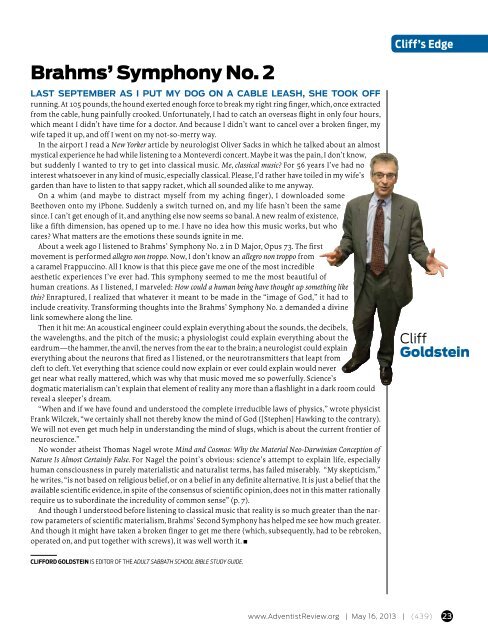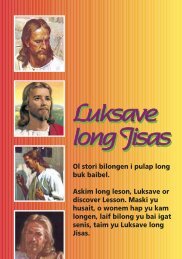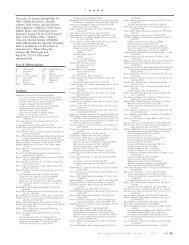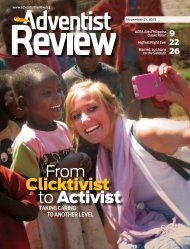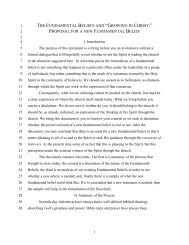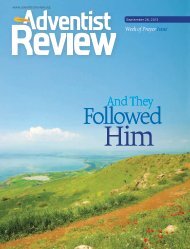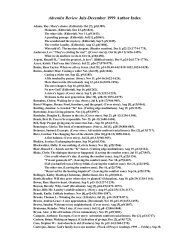Christ Kona?
Download PDF - Adventist Review
Download PDF - Adventist Review
- No tags were found...
You also want an ePaper? Increase the reach of your titles
YUMPU automatically turns print PDFs into web optimized ePapers that Google loves.
Cliff’s Edge<br />
Brahms’ Symphony No. 2<br />
Last September as I put my dog on a cable leash, she took off<br />
running. At 105 pounds, the hound exerted enough force to break my right ring finger, which, once extracted<br />
from the cable, hung painfully crooked. Unfortunately, I had to catch an overseas flight in only four hours,<br />
which meant I didn’t have time for a doctor. And because I didn’t want to cancel over a broken finger, my<br />
wife taped it up, and off I went on my not-so-merry way.<br />
In the airport I read a New Yorker article by neurologist Oliver Sacks in which he talked about an almost<br />
mystical experience he had while listening to a Monteverdi concert. Maybe it was the pain, I don’t know,<br />
but suddenly I wanted to try to get into classical music. Me, classical music? For 56 years I’ve had no<br />
interest whatsoever in any kind of music, especially classical. Please, I’d rather have toiled in my wife’s<br />
garden than have to listen to that sappy racket, which all sounded alike to me anyway.<br />
On a whim (and maybe to distract myself from my aching finger), I downloaded some<br />
Beethoven onto my iPhone. Suddenly a switch turned on, and my life hasn’t been the same<br />
since. I can’t get enough of it, and anything else now seems so banal. A new realm of existence,<br />
like a fifth dimension, has opened up to me. I have no idea how this music works, but who<br />
cares? What matters are the emotions these sounds ignite in me.<br />
About a week ago I listened to Brahms’ Symphony No. 2 in D Major, Opus 73. The first<br />
movement is performed allegro non troppo. Now, I don’t know an allegro non troppo from<br />
a caramel Frappuccino. All I know is that this piece gave me one of the most incredible<br />
aesthetic experiences I’ve ever had. This symphony seemed to me the most beautiful of<br />
human creations. As I listened, I marveled: How could a human being have thought up something like<br />
this? Enraptured, I realized that whatever it meant to be made in the “image of God,” it had to<br />
include creativity. Transforming thoughts into the Brahms’ Symphony No. 2 demanded a divine<br />
link somewhere along the line.<br />
Then it hit me: An acoustical engineer could explain everything about the sounds, the decibels,<br />
the wavelengths, and the pitch of the music; a physiologist could explain everything about the<br />
eardrum—the hammer, the anvil, the nerves from the ear to the brain; a neurologist could explain<br />
everything about the neurons that fired as I listened, or the neurotransmitters that leapt from<br />
cleft to cleft. Yet everything that science could now explain or ever could explain would never<br />
get near what really mattered, which was why that music moved me so powerfully. Science’s<br />
dogmatic materialism can’t explain that element of reality any more than a flashlight in a dark room could<br />
reveal a sleeper’s dream.<br />
“When and if we have found and understood the complete irreducible laws of physics,” wrote physicist<br />
Frank Wilczek, “we certainly shall not thereby know the mind of God ([Stephen] Hawking to the contrary).<br />
We will not even get much help in understanding the mind of slugs, which is about the current frontier of<br />
neuroscience.”<br />
No wonder atheist Thomas Nagel wrote Mind and Cosmos: Why the Material Neo-Darwinian Conception of<br />
Nature Is Almost Certainly False. For Nagel the point’s obvious: science’s attempt to explain life, especially<br />
human consciousness in purely materialistic and naturalist terms, has failed miserably. “My skepticism,”<br />
he writes, “is not based on religious belief, or on a belief in any definite alternative. It is just a belief that the<br />
available scientific evidence, in spite of the consensus of scientific opinion, does not in this matter rationally<br />
require us to subordinate the incredulity of common sense” (p. 7).<br />
And though I understood before listening to classical music that reality is so much greater than the narrow<br />
parameters of scientific materialism, Brahms’ Second Symphony has helped me see how much greater.<br />
And though it might have taken a broken finger to get me there (which, subsequently, had to be rebroken,<br />
operated on, and put together with screws), it was well worth it. n<br />
Cliff<br />
Goldstein<br />
Clifford Goldstein is editor of the Adult Sabbath School Bible Study Guide.<br />
www.AdventistReview.org | May 16, 2013 | (439) 23


